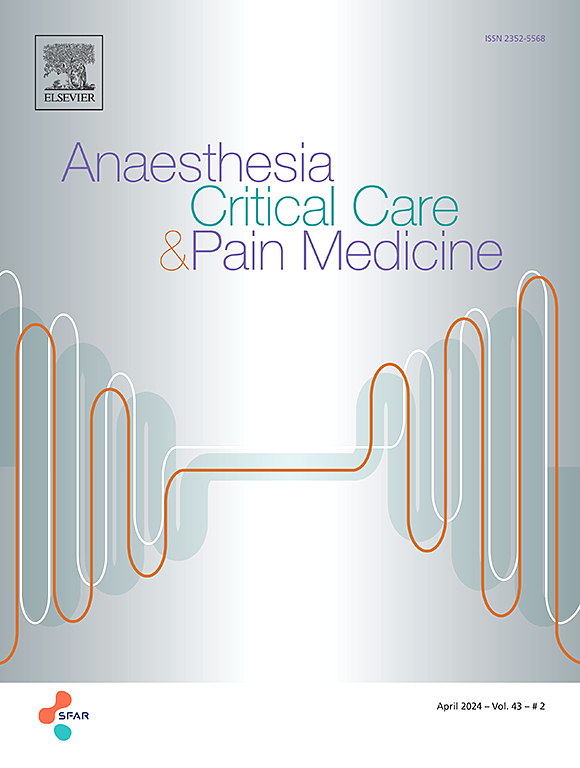Effects of intravenous paracetamol on mean arterial pressure in critically ill patients: A systematic review and meta-analysis with trial sequential analysis
IF 4.7
3区 医学
Q1 ANESTHESIOLOGY
引用次数: 0
Abstract
Background
Intravenous administration of paracetamol to critically ill patients may have negative hemodynamic effects. However, such effects have not been adequately quantified.
Methods
We conducted a systematic review and meta-analysis of observational studies (published in English language in PubMed and/or EMBASE) conducted on intensive care unit (ICU) patients, reporting hemodynamic changes within 30 min of intravenous paracetamol administration for fever and/or analgesia. The primary outcome was the mean difference (MD) with 95% confidence interval [95%CI] in mean arterial pressure (MAP). Secondary outcomes were systolic and diastolic arterial pressure (SAP and DAP), heart rate (HR), and incidence of hypotension. Trial sequential analysis (TSA) was conducted to ascertain the robustness of findings.
Results
Eight studies were included. We observed significant reduction after paracetamol of MAP (5 studies, MD: −6.75 mmHg [−10.68; −2.82]; p = 0.0008; I2 = 74%), SAP (5 studies, MD: −11.55 mmHg [−20.55; −2.55]; p = 0.01; I2 = 78%) and DAP (5 studies, MD: −5.29 mmHg [−8.53; −2.05]; p = 0.001; I2 = 42%). No effects were seen for HR (4 studies, MD: −3.08 bpm [−7.09;0.93]; p = 0.13; I2 = 0%). Subgroup analyses were hampered by the small number of studies. MAP reduction appeared consistent when paracetamol was administered for fever. TSAs showed that results on MAP and DAP were robust; SAP and HR were not. The grade of evidence was very low. The occurrence of hypotension after intravenous paracetamol was 45.5% (n = 143/314, 4 studies).
Conclusions
Hypotension after intravenous paracetamol is frequent in the ICU, with significant reduction in MAP, SAP, and DAP but no effects on HR. Effects seem more pronounced in patients with fever. More advanced hemodynamic studies are needed to understand the mechanisms of paracetamol-induced hypotension.
Registration
PROSPERO (CRD number 42024574919).
静脉注射扑热息痛对危重患者平均动脉压的影响:一项系统回顾和荟萃分析,采用试验序列分析。
背景:对危重病人静脉给予扑热息痛可能会对血流动力学产生负面影响。然而,这些影响还没有得到充分的量化。方法:我们对重症监护病房(ICU)患者的观察性研究(以英文发表在PubMed和/或EMBASE)进行了系统回顾和荟萃分析,这些研究报告了静脉注射扑热息痛治疗发热和/或镇痛30分钟内血液动力学的变化。主要终点是平均动脉压(MAP)的平均差值(MD), 95%可信区间[95% ci]。次要结局是收缩压和舒张压(SAP和DAP)、心率(HR)和低血压发生率。进行试验序列分析(TSA)以确定结果的稳健性。结果:纳入8项研究。我们观察到扑热息痛后MAP显著降低(5项研究,MD:-6.75 mmHg [-10.68;-2.82];p = 0.0008;I2 = 74%), SAP(5研究,MD: -11.55毫米汞柱[-20.55,-2.55];p = 0.01;I2 = 78%)和衣冠楚楚的(5研究,MD: -5.29毫米汞柱[-8.53,-2.05];p = 0.001;i2 = 42%)。HR未见影响(4项研究,MD:-3.08 bpm [-7.09;0.93];p = 0.13;i2 = 0%)。亚组分析因研究数量少而受到阻碍。当对乙酰氨基酚用于发热时,MAP减少出现一致。tsa结果表明,MAP和DAP具有较强的鲁棒性;SAP和HR则不然。证据的等级很低。静脉注射扑热息痛后低血压的发生率为45.5% (n = 143/ 314,4项研究)。结论:ICU患者静脉注射扑热息痛后低血压时有发生,MAP、SAP、DAP明显降低,但对HR无影响。对发烧患者的影响似乎更明显。需要更深入的血流动力学研究来了解扑热息痛诱发低血压的机制。注册:普洛斯彼罗(CRD号码42024574919)。
本文章由计算机程序翻译,如有差异,请以英文原文为准。
求助全文
约1分钟内获得全文
求助全文
来源期刊

Anaesthesia Critical Care & Pain Medicine
ANESTHESIOLOGY-
CiteScore
6.70
自引率
5.50%
发文量
150
审稿时长
18 days
期刊介绍:
Anaesthesia, Critical Care & Pain Medicine (formerly Annales Françaises d''Anesthésie et de Réanimation) publishes in English the highest quality original material, both scientific and clinical, on all aspects of anaesthesia, critical care & pain medicine.
 求助内容:
求助内容: 应助结果提醒方式:
应助结果提醒方式:


